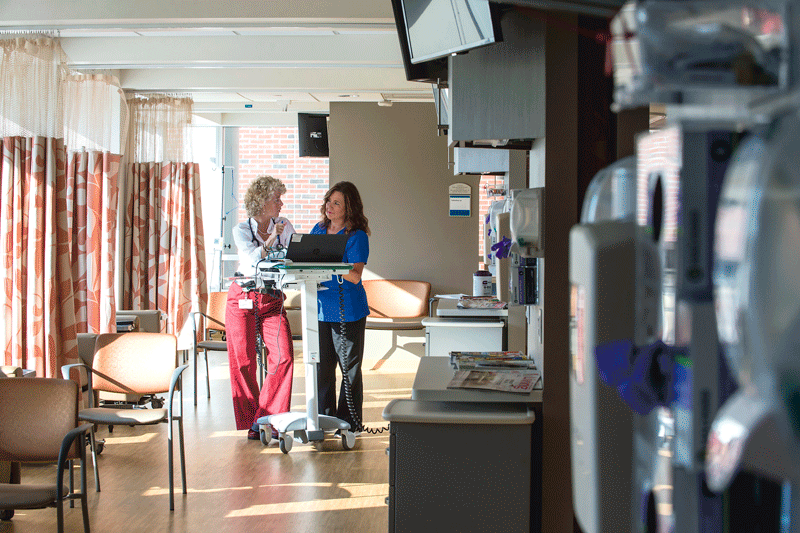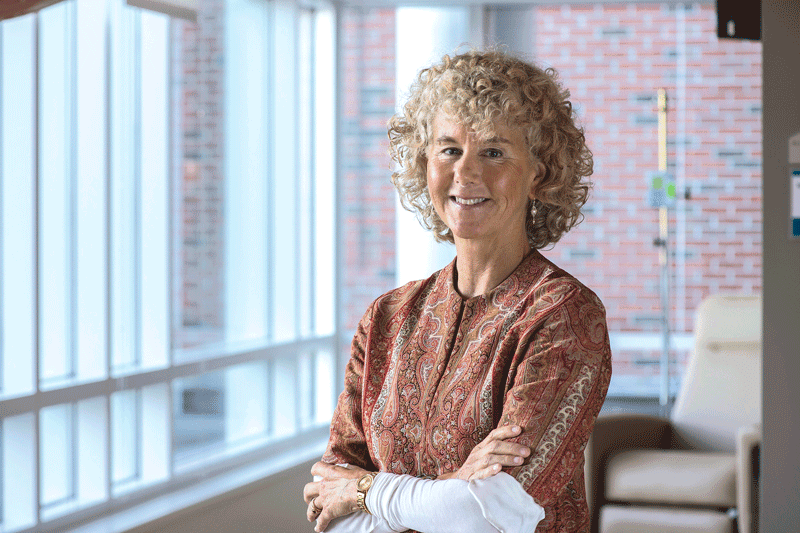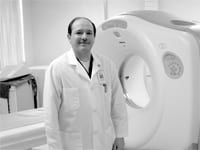The Best of Both Worlds
Mass General Cancer Center Continues Process of Evolution
Opened almost two years ago, the Mass General Cancer Center at Cooley Dickinson Hospital is a stunning example of collaboration in motion, if you will. The center brings a host of services together under one roof, but it also brings the vast resources of Mass General to CDH and the people it serves. The collaboration that created and designed the center is rock solid, but it also continues to evolve and add new layers to a unique partnership.
By George O’Brien

Dr. Lindsey Rockwell calls it “the gift that keeps on giving.”
As she spoke those words, she acknowledged that they form a somewhat old, well-worn cliché used, to one degree of effectiveness or another, in a wide array of forums.
But when it comes to the Mass General Cancer Center at Cooley Dickinson Hospital, it works, said Rockwell, a medical oncologist and hermatologist now affiliated with the center.
She told HCN that when the center was conceptualized several years ago, it was envisioned as a facility where a host of specialists and services would come together under one roof, bringing higher levels of convenience and lower levels of stress to both patients and their families.
It was also blueprinted to become a truly unique asset for the region, one that would essentially make the vast resources of Massachusetts General Hospital and its oncologists available to individuals in this region — often without them having to travel to Boston.
And the center has become all of that and much more, said Rockwell as she talked about the facility nearly two years after it officially opened its doors. This is what she meant by that ‘gift that keeps on giving’ comment, before elaborating and reshaping her thoughts.
“Part of the beauty of this relationship is the idea of creating a new paradigm in oncology care where the patient can have their care in their backyard, with a world-renowned academic and research hospital at their fingertips when and if they need it,” she said. “And as a community oncologist, I believe this allows the patient to have the best of both worlds.
“They can have the intimacy and ease of a community hospital,” she went on. “And they can have access to the experts that are writing the data and doing the research in the field of their disease. They can get that here and not have to drive to Boston every week.”
As she talked about the $5 million, 16,400-square-foot facility center and its first few years of operation, Rockwell came back repeatedly to that subject of stress — an all-important matters wen it comes to diagnosing and treating cancer — and how those at the center work collaboratively and effectively to reduce it.
“The patient doesn’t have to go see ‘A,’ ‘B,’ and ‘C’ — ‘A,’ ‘B,’ and ‘C’ come to the patient,” she went on. “And I think part of what that allows is for less stress. If the patient has a new cancer diagnosis, which obviously a terribly stressful time for them … by creating a system that works toward them, the intention is to alleviate the stress, their stress, and organize around them.”
For this issue and its focus on cancer care, HCN talked at length with Rockwell about the center, the collaboration that created it and continues to fuel it, and this system designed to work for the patient.
Center of Attention
Rockwell said the seeds for the cancer center were planted perhaps as early as 2009, when a dialogue was generated with specialists at Mass General about what such a facility could and should look like — and how it would operate.
She called these the “courting stages.”
“Our go-to consultations to experts became our colleagues at Mass General,” she explained. “I think they had us on their radar for consideration for a satellite facility, and we had them on our radar for a replacement for Dartmouth Hitchcock (the former parent company for Cooley Dickinson Hospital).
“The oncology program was really the pilot program to establish a rapport with our colleagues in Boston,” she went on. “And it went really well.”
Elaborating, she said those both side of this pilot program developed a very fluid process of discussing patients, getting patients to Boston if they needed to be seen in Boston, and opening up a fast-track discussion of appropriate clinical trials.
“That groundwork was set over several years, and it led to the formal dialogue that created the actual affiliation,” she explained, adding that all this what not what she would call a natural process, but rather a “natural evolution” of a relationship or collaboration.
“It was like … ‘OK, we like you, and you like us, this is working — let’s do it,” she told HCN. “ ‘And let’s broaden it and deepen it, and make it more specific, and define it — and agree to agree and create a relationship.”
And this process of evolution has continued, meaning it certainly didn’t end when the cancer center opened its doors in the fall of 2015, she said.
As an example, she cited a growing platform of videoconferences staged at the center and involving colleagues at Mass General. There are now three of them; one is a weekly breast cancer conference, another is focused on multiple myloma and takes place roughly every other month with the goal of eventually becoming monthly, and the third is a broader tumor conference staged monthly.
These conferences provide unique opportunities for both the oncologists based at Cooley Dickinson and their patients, Rockwell explained.
“It’s an informal way of getting a second opinion with more complicated cases, she toldHCN, adding that this is just one of many ways of bringing everything that Mass General offers to patients in this region, and just one example of ongoing evolution.
As for the center itself, Rockwell said its creation, specific design elements, and roster of services was, in itself, an exercise in collaboration.
“We met regularly — every month as the go-live time got closer — and discussed things as a group,” she explained. “That means everything from operations — where should the exam rooms go? And the infusion suite? Where is the waiting room? What is the flow process, from a patient coming in the door to the exam room to the infusion suite? Needless to say, that was an extraordinary amount of collaboration, and our colleagues were an intimate part of those decisions.
“And what’s interesting is that, while they were an intimate part of those decisions, they want us as a community hospital to have our own voice and have our own autonomy,” she went on. “And this is a big part of why I think this works — knowing that we have them in our back pocket if we want advice or counseling on a certain issue.”
Beyond access to the resources at Mass General, convenience is at the heart of the center’s creation and design, said Rockwell, adding that cancer care is now centralized at the facility.
“They have their labs done in one place, see their oncologist at that same place, and also have their scans done and their chemotherapy at the same place,” she explained, adding that radiation is one flight below the cancer center, and a new, multi-disciplinary breast clinic now in the planning stages will just one hallway away.
And this brings her back again to that broad mission of alleviating stress — for patients, obviously, but also for physicians as well, because of the ‘one roof’ nature of this facility and the manner in which it improves communication between members of a patients’ team.
“All the doctors are talking to each other in real time,” she explained. “That alleviates a lot of stress on the physicians, because having each other right there cuts back on phone calls and not being able to reach people; we get to sit down and have the conversations, and come to an agreement on the patient’s plan as a team.”
Coming Together
As she talked about life before the center was created and contrasted it with operations now, Rockwell said that before, things were ‘separate’ — a word she eventually preferred over ‘fragmented,’ although she used them both —and now they are integrated.
And the change is significant for all parties involved — specialists delivering care, their patients, and the patients’ families — because integrated translates directly into “more patient centered,” she explained, which is the quality that those who orchestrated this collaboration and the cancer center itself had in mind when they did so.
“Because we’re all under one roof, the plan for the patient’s care is driven by the patient, the diagnosis, and the team taking care of them.”
This is what she meant by the center being a gift that keeps on giving — a development will continue, just as the center and the collaboration behind it continue to evolve.




Comments are closed.